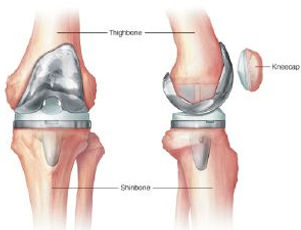Dr. Imthiaz Ahammed
JOINT REPLACEMENT

JOINT REPLACEMENT HIP, KNEE & SHOULDER
ABOUT
Professor and Unit Head
Yenepoya Medical College Mangalore
TREATMENTS
HIP REPLACEMENT
KNEE REPLACEMENT
SHOULDER REPLACEMENT
DEFORMITY CORRECTION
BACK ACHE
SPINAL PROBLEMS
COLD ORTHOPAEDICS
LOCATION
Westgate Terminus Opp. Unity Hospital, Falnir, Mangalore
Phone : (91) 0824 – 3253628
Mobile : 9845082578
Email: drimthiaz@hotmail.com
Dr. Imthiaz Ahammed
SYNOPSIS OF JOINT REPLACEMENT
What is Osteoarthritis
Osteoarthritis is mostly related to ageing. With ageing, the water content of the cartilage decreases & the protein make of cartilage degenerates. Repetitive use of the joints over the years irritates & inflames the cartilage, causing joint pain & swelling. Eventually, cartilage begins to degenerate by flaking or forming the tiny crevices in advanced cases. There is a total loss of cartilage cushion between the bones of the joints. Loss of cushion causes friction between the bones, leading to pain & limitation of joint mobility.
Obesity causes
Next to ageing, obesity is the most powerful risk factor for osteoarthritis of the knees. Repeated trauma to joint tissues (ligaments, bones & cartilage) leads to early osteoarthritis of the joints. Osteoarthritis by increasing the mechanical stress on the cartilage. Some people are born with abnormally formed joints (congenital abnormalities) that are vulnerable to mechanical wear, causing early degeneration & loss of joint cartilage. Osteoarthritis of the hip joints is commonly elated to the design abnormalities of these joints that had been present since birth or developed later.

What are the symptoms of Osteoarthritis
The most common symptoms of osteoarthritis is pain in the affected joints after repetitive use. Joint pain is usually worse later in the day. There can be swelling, warmth & creaking of the affected joints. In severe osteoarthritis complete loss of cartilage cushion causes friction between bones, causing pain at rest or pain with limited motion also. Progressive cartilage degeneration of the knee joints can lead to deformity & outward curvature of the knees referred to as “bow leg”. Patients with osteoarthritis of the weight bearing joints (like the knees) can develop a limp. The limp can worsen as more cartilage degenerates.

What can you do for Arthritis of Joints
-
Loose weight
-
Pain killers, antiinflammatory
-
Physhiotherapy
-
Walking aids, like crutches & cane
-
Steroid injections to the joints
Who will need joint replacement
You will need Joint replacement if,
-
You suffer from knee & hip pain restricting your daily activities like walking, praying, climbing, stairs.
-
You have deformity of the knee & hip.
-
Stiffness of hip & knee preventing its normal movement.
-
Joint is not stable.

Who can under go joint replacement
-
Joint replacement is done in adults aged between 60 to 80 years usually, even though it can be done in any age group.
-
It is done when all non surgical methods of treatments fails to give relief of symptoms.
-
Commonest indication for joint replacement is osteoarthritis.

How is joint replacement performed
-
Patient is given usully regional anaesthesia.
-
The damaged ends of thigh bone (Femur) & leg bone (Tibia) are cut away.
-
The ends are shaped to fit the appropriate sized prosthesis.
-
The bone ends are cleaned & prosthesis fitted with bone cement.
-
A plastic spacer is placed between the two metal prosthesis which reduces the friction of the joint surfaces.

What is the recovering process
Usually patients gets good pain relief immediately & can be made to walk next day. He will be given physiotherapy & specific exercise for the next few days to restore the knee movement & muscle strength. Patient will be usually discharged in four to five days from the hospital. Most of the people resume leisure activities in 3 to 4 weeks. However it may take around 6 to 8 weeks for patients to resume his normal activities & driving.
What are the possible complications
Nowadays most of the patients rarely have any complications. Surgical infections are very rare. Normal wear & tear of the artificial joint is expected, But over 90% of the artificial joints were found to be still working after 15years, according to trent regional arthroplasty study of U.K. Activities like high impact sports should be avoided however for 6 months.

What are the benefits of joint replacement
-
Dramatically reduces joint pain.
-
Improves the range of movement and the over all quality of life.
-
Since the life expectancy is improving now, it helps people to remain active even at old age.